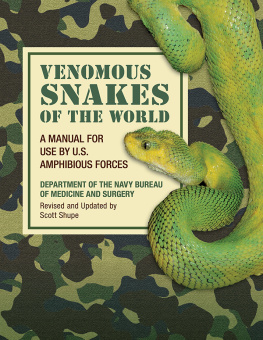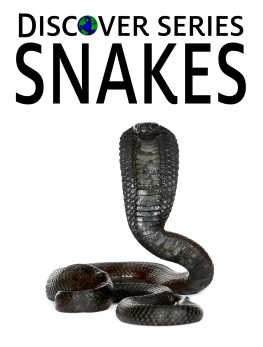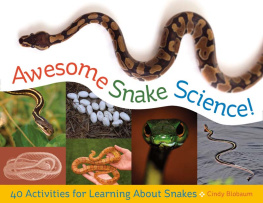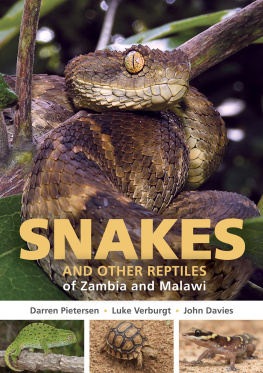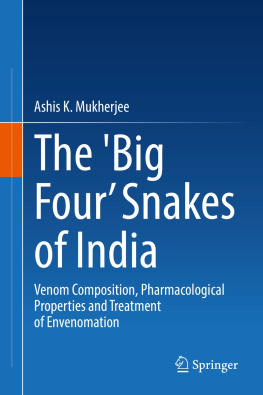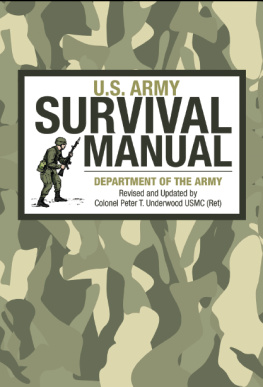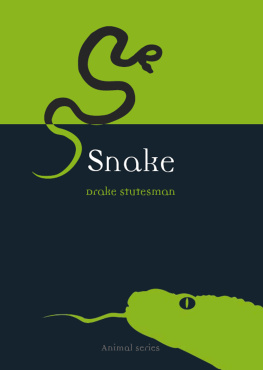VENOMOUS SNAKES
OF THE WORLD
VENOMOUS SNAKES
OF THE WORLD
A Manual for Use by U.S. Amphibious Forces
Based on Poisonous Snakes of the World
by the Department of the Navy,
Bureau of Medicine and Surgery
Revised and Updated by
Scott Shupe

SKYHORSE PUBLISHING
Additional material and compilation copyright 2013 by Scott Shupe
No claim is made to material contained in this work that is derived from government documents. Nevertheless, Skyhorse Publishing and Scott Shupe claim copyright in all additional content, including, but not limited to, compilation copyright and the copyright in and to any additional material, elements, design, images, or layout of whatever kind included herein.
All inquiries should be addressed to Skyhorse Publishing,
307 West 36th Street, 11th Floor, New York, NY 10018.
Skyhorse Publishing books may be purchased in bulk at special discounts for sales promotion, corporate gifts, fund-raising, or educational purposes. Special editions can also be created to specifications. For details, contact the Special Sales Department, Skyhorse Publishing, 307 West 36th Street, 11th Floor, New York, NY 10018 or info@skyhorsepublishing.com.
Skyhorse and Skyhorse Publishing are registered trademarks of Skyhorse Publishing, Inc., a Delaware corporation.
Visit our website at www.skyhorsepublishing.com.
10 9 8 7 6 5 4 3 2 1
Library of Congress Cataloging-in-Publication Data is available on file.
ISBN: 978-1-62087-623-7
Printed in China
CONTENTS
Introduction
Nearly half a century ago in 1965, three of the worlds most noted herpetologists and medical professionals, in conjunction with the United States Navys Bureau of Medicine and Surgery, cooperated to produce what at that time was perhaps the most comprehensive publication on the worlds venomous snake species yet published. The book, Poisonous Snakes of the World, quickly became an important reference, not only for military personnel, but also medical professionals, herpetologists, and reptile keepers. Even today it remains a popular book among naturalists, book collectors, zoo personnel, and snake enthusiasts. In keeping with the current understanding of the terms Poisonous vs. Venomous, the word poisonous has been changed to venomous in the title and throughout the text of this new manual.
This volume was inspired by the epic work Poisonous Snakes of the World, from nearly fifty years ago. Many reptile enthusiasts over the years have mused aloud about their yearnings for an updated version of that original publication, complete with color photos rather than black and white, and encompassing all the new species that were unknown or omitted from the 1965 edition. This project was conceived as a revised and updated version of Poisonous Snakes of the World. However, it soon became apparent to the author that the body of knowledge about venomous snakes has evolved enormously through the decades. In Poisonous Snakes of the World, there were less than 175 species of venomous snakes described. Today, the number of venomous snake species known to science exceeds 600. In addition to many new species having been described, many subspecies have been elevated to full species status, and in some instances there are species that are now assigned to entirely different genera. Even more dramatic, taxonomic changes have resulted in a few species being assigned to entirely different families.
In a classic example of how much the taxonomy of venomous snakes has changed since the publication of Poisonous Snakes of the World in 1965, the cobra species Naja anchietae (Ancheitas Cobra) was once considered to be a subspecies of Naja annulifera (Snouted Cobra). Meanwhile, the Snouted Cobra was formerly regarded as a subspecies of Naja haje (Egyptian Cobra). Thus, what was regarded in 1965 as a single species has now become three species in Africa with a fourth newly described species in the Arabian Peninsula. An even greater example are the Saw-scaled Vipers (Echis) which once consisted of only two species but now boast eleven recognized species and several subspecies within some of those eleven species. The North American rattlesnake species Crotalus viridis (Prairie Rattlesnake) was for many years regarded as a polymorphic species consisting of eight subspecies. It is now known that the complex formerly known as the Prairie Rattlesnakes contains six separate species (according to the Center for North American Herpetology). These are just a few examples of the extent of the changes that have occurred in the study of these animals over the last five decades.
While this book was inspired by the 1965 publication Poisonous Snakes of the World, this writer does not presume to possess the knowledge and expertise of the original authors. It is hoped by the revisionist author that this book will stand on its own merit and gain acceptance and use by both the U.S. military as well as the herpetological community.
In deference to the those early giants who produced Poisonous Snakes of the World; and upon whose shoulders this author and indeed all modern herpetologists stand, I have elected to include in this volume (where still appropriate) many excerpts and direct quotes from that 1965 book. The original authors were in a class far above this writers status insofar as their scientific credentials and capabilities are concerned. Their work was peer reviewed and they themselves were selected for the task of writing the original book by the American Society of Icthyologists and Herpetologists.
Insofar as the taxonomic nomenclature used in this manual is concerned, this author found many diverse and varying views on the subject. It is in many ways heartening to see so much work being done on venomous snakes by researchers around the world, but also somewhat frustrating to be writing a book at a time when there is so much new and divergent research being conducted. The conclusions of the various researchers are often in conflict and as a result the current taxonomy of many species is controversial. Faced with these conflicting opinions (or as the researchers themselves would say evidence), the author was forced to make a choice regarding whose evidence was most acceptable.
In this case that difficult task was made easier due to the fact that this book is intended as a manual for U.S. military personnel. The Information Services Division of the Armed Forces Pest Management Board relies heavily upon the taxonomic classification used by the EMBL Reptile Database (personal communication, Harold Harlan). The Reptile Database is a website published by the European Molecular Biological Laboratory. While there are many within the professional herpetological community that do not follow completely everything contained in the Reptile Database, there are others who do accept its version of current reptile taxonomy. Moreover, as this book is intended mainly as a military manual, it seems logical to follow the same guidelines used by the Armed Forces Pest Management Board. For the most part that has been done in this manual. However, I have deviated at times from what is contained within the Reptile Database. For instance, in dealing with North American species, I have followed the classifications used by the Center for North American Herpetology, notably the publication Standard Common and Current Scientific Names for North American Amphibians, Turtles, Reptiles & Crocodilians (Collins & Taggart 2009). Likewise in chapter 14 (USPACOM-Part 2) which deals with mainly Australian species, I have at times deferred to the classification used by two Australian sources. One was the University of Adelaides Clinical Toxinology Resources website (www.toxinology.com) and the other was a website known as the Australian Reptile Online Database (www.arod.com.au/).

